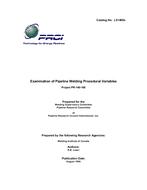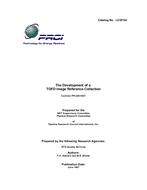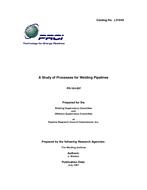Provide PDF Format
PRCI PR-140-168
- Examination of Pipeline Welding Procedural Variables
- Report / Survey by Pipeline Research Council International, 08/01/1984
- Publisher: PRCI
$48.00$95.00
L51465e
Welding Institute of Canada
Need: The predominant means of oil and gas distribution is by large diameter pipelines; which are field welded using either manual or semi-automatic procedures. The hydrogen-induced cracking problems encountered with construction projects, have been attributed to chemistry, hydrogen content of the weld, and the applied stresses. The stresses across the joint, and in particular the root run, are not always known exactly, and can have a significant influence on crack susceptibility. These can be caused by the action of the line-up clamp, mismatch of adjoining pipes, and lifting of the pipe for overall alignment while the girth welds are only partially completed.
Result: This project quantified the effects of lift height and misalignment on the susceptibility of girth welds to hydrogen-induced cracking and compared GMAW and FCAW procedures to standard cellulosic welds. The high restraint cracking test developed at the Welding Institute of Canada was used to compare the crack susceptibilities for the root passes. Parallel sets of tests were conducted on a 0.13%C and a 0.08%C steel, using Phoenix Cel 80, Linde 65, and Lincoln NR205 consumables. The results of the tests were compared in terms of the critical cooling time to 100° C of the root pass, which was necessary to prevent cracking. The increased susceptibility with higher restraint was identical for both steels and it was shown that increasing the restraint by 500 kg/mm2 would require an additional 150 s to cool to 100°C to prevent cracking. The cooling time was also longer when a misalignment of 1.6 mm was introduced into the joint, but the effect of misalignment was minimal as the restraint decreased.
Benefit: The effects of lift height and misalignment on the susceptibility of the root run of a girth weld to hydrogen-induced cracking were examined using the high restraint cracking test. This test was also used to compare directly the relative cracking tendencies of root runs deposited using SMAW, GMAW, and FCAW. The results of the tests were compared in terms of the critical cooling time to 100°C to prevent cracking. The relative susceptibilities of the three processes examined ranked the consumables as follows: the GMAW process exhibits the best resistance to hydrogen cracking, followed by the SMAW electrode which was just slightly better than the FCAW consumable.
Welding Institute of Canada
Need: The predominant means of oil and gas distribution is by large diameter pipelines; which are field welded using either manual or semi-automatic procedures. The hydrogen-induced cracking problems encountered with construction projects, have been attributed to chemistry, hydrogen content of the weld, and the applied stresses. The stresses across the joint, and in particular the root run, are not always known exactly, and can have a significant influence on crack susceptibility. These can be caused by the action of the line-up clamp, mismatch of adjoining pipes, and lifting of the pipe for overall alignment while the girth welds are only partially completed.
Result: This project quantified the effects of lift height and misalignment on the susceptibility of girth welds to hydrogen-induced cracking and compared GMAW and FCAW procedures to standard cellulosic welds. The high restraint cracking test developed at the Welding Institute of Canada was used to compare the crack susceptibilities for the root passes. Parallel sets of tests were conducted on a 0.13%C and a 0.08%C steel, using Phoenix Cel 80, Linde 65, and Lincoln NR205 consumables. The results of the tests were compared in terms of the critical cooling time to 100° C of the root pass, which was necessary to prevent cracking. The increased susceptibility with higher restraint was identical for both steels and it was shown that increasing the restraint by 500 kg/mm2 would require an additional 150 s to cool to 100°C to prevent cracking. The cooling time was also longer when a misalignment of 1.6 mm was introduced into the joint, but the effect of misalignment was minimal as the restraint decreased.
Benefit: The effects of lift height and misalignment on the susceptibility of the root run of a girth weld to hydrogen-induced cracking were examined using the high restraint cracking test. This test was also used to compare directly the relative cracking tendencies of root runs deposited using SMAW, GMAW, and FCAW. The results of the tests were compared in terms of the critical cooling time to 100°C to prevent cracking. The relative susceptibilities of the three processes examined ranked the consumables as follows: the GMAW process exhibits the best resistance to hydrogen cracking, followed by the SMAW electrode which was just slightly better than the FCAW consumable.
Related Products
PRCI PR-3-504
Effect of Water Chemistry on Internal Corrosion Rates in Offshore Natural Gas Pipelines..
$6.00 $12.00




